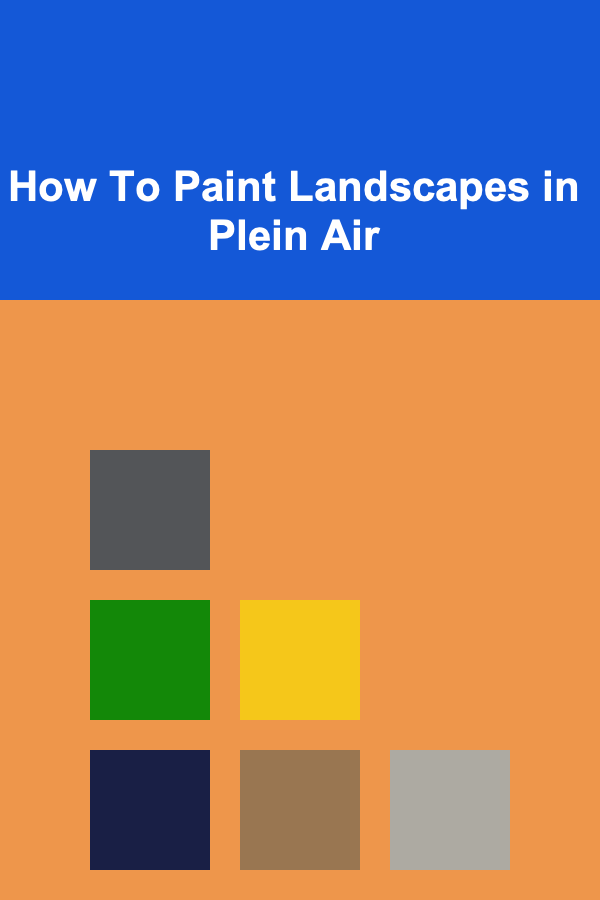
How To Paint Landscapes in Plein Air
ebook include PDF & Audio bundle (Micro Guide)
$12.99$5.99
Limited Time Offer! Order within the next:

Plein air painting, a term borrowed from the French meaning "open air," is the practice of painting natural scenes outdoors, directly from the landscape. This method allows artists to capture the light, atmosphere, and environment in real-time, offering a vivid, immediate, and emotional connection to the landscape. It has been practiced by some of the greatest painters in history, such as Claude Monet and the Impressionists, and it continues to inspire artists of all levels.
If you are interested in learning how to paint landscapes in plein air, this guide will take you step by step through the process, offering practical tips and insights for creating compelling and dynamic landscape paintings in the great outdoors.
The Essentials of Plein Air Painting
Understanding the Plein Air Experience
Before diving into the technical aspects, it's essential to grasp the spirit of plein air painting. It's not just about painting what you see---it's about experiencing the environment in its entirety. This includes being sensitive to the changing light, weather, sounds, and even the physical sensation of being outdoors.
Plein air painting requires a certain mindset: one of patience, adaptability, and flexibility. Nature is ever-changing, and the weather can shift unexpectedly. The landscape you start painting in the morning may look vastly different by the time you finish. The light can dramatically alter the colors of the scene, and cloud cover can shift the shadows and highlights in the blink of an eye. It's this dynamic aspect that makes plein air painting such a thrilling and rewarding challenge.
The Equipment You'll Need
Plein air painting involves working on location, which means that portability and practicality are paramount. Unlike studio work, where you can have a large and permanent setup, plein air artists need a compact, portable toolkit that can be set up quickly and efficiently. Below is a list of essential materials you'll need for plein air painting:
1. Canvas or Paper
- Canvas Panels: These are portable and sturdy, providing a good surface for oil or acrylic paints.
- Watercolor Paper: If you're using watercolors, high-quality, thick watercolor paper is ideal for outdoor painting.
2. Easel
- Portable Easels: Plein air easels are lightweight and can easily be carried. They come in many forms, including tripod, box, and French-style easels, each offering different features. The French easel, for instance, includes a built-in storage compartment for paints and brushes.
3. Paints
- Oils: If you're using oils, you'll want a set of quick-drying oils, such as those designed for outdoor use. A small palette of essential colors will suffice for most scenes.
- Acrylics: Acrylic paints dry faster than oils and are less affected by changes in humidity, making them an excellent choice for plein air.
- Watercolors: Watercolors are light and easy to carry, offering a quick and spontaneous way to capture the landscape.
4. Brushes
- Bring a variety of brushes---flat, filbert, round, and stiff bristle brushes---for different textures and techniques.
- Remember to pack a cleaning solution, such as turpentine (for oils) or water (for watercolors), to clean your brushes.
5. Palette
- A palette allows you to mix your colors, and it's essential to have one that is easy to transport and clean.
6. Palette Knives
- For mixing paints and sometimes for applying paint in an impasto style, a palette knife is an essential tool in your kit.
7. Other Essentials
- Outdoor Chair: A lightweight, foldable chair will provide comfort during long sessions.
- Storage Box: A box to store your paints, brushes, and other materials is a must.
- Hat, Sunscreen, and Water: Be prepared for the elements, whether it's sun, rain, or wind.
- Sketchbook and Pencils: For quick sketches or making notes about the scene before painting.
Choosing the Right Location
Selecting the right location for your plein air painting session is vital. You need a spot that offers a dynamic view, good lighting, and interesting details, yet isn't so complex that it's overwhelming to paint.
Here are a few tips for choosing a location:
- Consider Light and Time of Day: Light changes throughout the day, so the time of day significantly impacts how you perceive the landscape. Early morning and late afternoon tend to offer the best lighting conditions for outdoor painting, as the sun is lower in the sky and provides softer, more flattering light.
- Look for Interesting Features: Focus on natural features like trees, hills, lakes, or mountains. Interesting patterns and shapes in the landscape make the painting process more enjoyable and visually compelling.
- Avoid Overcrowded or Highly Detailed Scenes: A scene that's too complex might leave you feeling overwhelmed. Instead, opt for simpler compositions that allow you to focus on the essentials.
- Safety and Comfort: Ensure the location is safe and accessible. If you're painting near water or a cliff, take necessary precautions. You should also make sure you're comfortable during your painting session, so bring a portable chair and water to stay hydrated.
Understanding the Light and Atmosphere
Plein air painting requires an acute awareness of the changing light throughout the day. The atmosphere and the light's intensity can completely alter the mood of a landscape. Early in the morning, the light is soft and cool, creating long shadows and rich colors. By midday, the light becomes harsh, with sharp shadows and bright highlights. As the day progresses, the light softens again, often taking on a warm, golden tone as the sun sets.
To capture the most accurate representation of the landscape, it's important to note the light's effect on the colors and shadows in the scene. Consider how the sunlight interacts with the landscape---does it create dramatic contrasts, or does it illuminate a specific feature of the scene?
Here are some tips for working with light:
- Value Study: Before starting your painting, spend a few moments assessing the light in terms of values (light and dark areas). This will help you create a balanced and harmonious composition.
- Color Temperature: The color temperature of light (warm or cool) will influence the overall palette you use. Early morning light tends to have cooler tones, while late afternoon light takes on a warmer hue.
Steps to Paint a Landscape in Plein Air
1. Start with a Sketch
Once you've chosen your location and set up your materials, begin by sketching the basic shapes and outlines of the landscape. Use a pencil or thin brush to outline the main elements, such as trees, hills, water, and buildings. Keep the sketch loose and simple to capture the scene's essence.
Many plein air artists focus on capturing the broad shapes and composition in the early stages, rather than getting caught up in fine details. Your goal at this stage is to block in the composition, considering how elements fit together within the canvas.
2. Block in the Big Shapes
Once you've established the composition, start blocking in the larger shapes with broad strokes of color. Don't focus on details just yet---concentrate on the major planes of the landscape, such as the sky, ground, trees, and water. Use large brushes and broad strokes to quickly lay down the main colors.
In plein air painting, it's important to work quickly, as the light will change over time. Blocking in large areas of color allows you to capture the overall tone and structure of the scene without getting bogged down in details.
3. Add Layers and Detail
Once the major shapes are blocked in, begin layering in more details and refining the composition. Start adding finer textures to the trees, rocks, and foliage. Pay close attention to how the light interacts with the surface of objects. Observe subtle color changes and use glazing techniques to add depth to your painting.
This is the stage where you can focus on nuances in color and texture---whether it's the variation in greens in the trees or the reflection of the sky in the water. Be sure to keep your brushstrokes fresh and energetic, avoiding overworking the painting.
4. Use Impasto for Texture
Impasto, a technique where paint is applied thickly to create texture, can be effective in plein air painting. This can be especially useful for adding highlights or creating the texture of trees, rocks, or other surface features. Apply paint in thicker layers to make certain elements stand out or create a three-dimensional effect.
5. Work with Atmosphere and Light
As the day progresses, the light will shift, and the atmosphere will change. Be mindful of how these changes impact your painting. The light may become warmer in the late afternoon or cooler in the early morning, so adjust your color palette accordingly.
Capture the essence of the landscape by focusing on the overall atmosphere rather than getting bogged down in small details. Consider the landscape as a whole---how the light and color shape the environment---and aim to convey this with a few broad strokes of color.
6. Finishing Touches
Once you've worked through the painting and are satisfied with the overall composition, add finishing touches. Refine any details that need attention and make sure the light, color, and atmosphere are cohesive. Step back often to assess the overall balance of the painting and make necessary adjustments.
7. Sign and Pack Up
Finally, when you're happy with the painting, sign your name in a corner. Remember that plein air painting is as much about the experience as it is about the finished product. You've captured a moment in time, and that's something unique.
Once finished, carefully pack up your materials. Take a moment to reflect on your experience outdoors and how it contributed to your artistic growth.
Conclusion
Plein air painting offers a unique way to engage with nature and develop your artistic skills. It challenges you to work quickly, adapt to the environment, and capture the beauty of the world in real time. Whether you're an experienced artist or a beginner, painting landscapes outdoors will deepen your connection to the natural world and inspire you to create dynamic, vibrant works of art.
With the right materials, a keen eye for light and atmosphere, and a sense of adventure, plein air painting is an incredibly rewarding practice. Embrace the challenges, enjoy the process, and let the landscape guide you in your artistic journey.

How to Organize a Holiday Decoration Swap with Friends
Read More
How to Use Bonds as a Safe Investment Option
Read More
How to Use Labels for Quick Organization of Music Materials
Read More
How to Use Blockchain for Healthcare Records
Read More
Maintaining Your Hydration Pack Cleaning Kit: A Comprehensive Guide
Read More
How to Build a Pre-Publishing Checklist for Bloggers
Read MoreOther Products

How to Organize a Holiday Decoration Swap with Friends
Read More
How to Use Bonds as a Safe Investment Option
Read More
How to Use Labels for Quick Organization of Music Materials
Read More
How to Use Blockchain for Healthcare Records
Read More
Maintaining Your Hydration Pack Cleaning Kit: A Comprehensive Guide
Read More